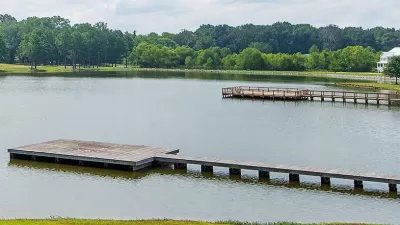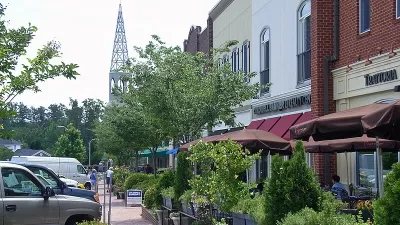Galina Tachieva's new Sprawl Repair Manual creates a narrative and visual process for making suburbs more sustainable. The book's first chapter is available now online.
Tachieva explains what she sees as sprawl:
"Sprawl is a pattern of growth characterized by an abundance of congested highways, strip shopping centers, big boxes, office parks, and gated cul-de-sac subdivisions-all separated from each other in isolated, single-use pods. This land-use pattern is typically found in suburban areas, but also affects our cities, and is central to our wasteful use of water, energy, land, and time spent in traffic. Sprawl has been linked to increased air and water pollution, greenhouse gas emissions, loss of open space and natural habitat, and the exponential increase in new infrastructure costs. Social problems related to the lack of diversity have been attributed to sprawl, and health problems such as obesity to its auto-dependence.
In contrast, complete communities have a mix of uses and are walkable, with many of a person's daily need-shops, offices, transit, civic and recreational places-within a short distance of home. They are compact, so they consume less open space and enable multiple modes of transportation, including bicycles, cars, and mass transit. A wide variety of building types provides options to residents and businesses, encouraging diversity in population. This mix of uses, public spaces, transportation, and population makes complete communities economically, socially, and environmentally sustainable."
Thanks to Simmons Buntin
FULL STORY: Sprawl Repair: From Sprawl to Complete Communities

Manufactured Crisis: Losing the Nation’s Largest Source of Unsubsidized Affordable Housing
Manufactured housing communities have long been an affordable housing option for millions of people living in the U.S., but that affordability is disappearing rapidly. How did we get here?

Americans May Be Stuck — But Why?
Americans are moving a lot less than they once did, and that is a problem. While Yoni Applebaum, in his highly-publicized article Stuck, gets the reasons badly wrong, it's still important to ask: why are we moving so much less than before?

Using Old Oil and Gas Wells for Green Energy Storage
Penn State researchers have found that repurposing abandoned oil and gas wells for geothermal-assisted compressed-air energy storage can boost efficiency, reduce environmental risks, and support clean energy and job transitions.

Greening Oakland’s School Grounds
With help from community partners like the Trust for Public Land, Oakland Unified School District is turning barren, asphalt-covered schoolyards into vibrant, green spaces that support outdoor learning, play, and student well-being.

California Governor Suspends CEQA Reviews for Utilities in Fire Areas
Utility restoration efforts in areas affected by the January wildfires in Los Angeles will be exempt from environmental regulations to speed up the rebuilding of essential infrastructure.

Native American Communities Prepare to Lead on Environmental Stewardship
In the face of federal threats to public lands and conservation efforts, indigenous groups continue to model nature-centered conservation efforts.
Urban Design for Planners 1: Software Tools
This six-course series explores essential urban design concepts using open source software and equips planners with the tools they need to participate fully in the urban design process.
Planning for Universal Design
Learn the tools for implementing Universal Design in planning regulations.
Heyer Gruel & Associates PA
City of Moreno Valley
Institute for Housing and Urban Development Studies (IHS)
City of Grandview
Harvard GSD Executive Education
Salt Lake City
NYU Wagner Graduate School of Public Service
City of Cambridge, Maryland





























